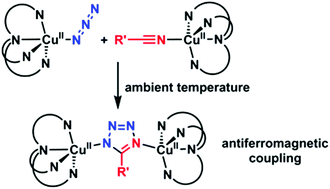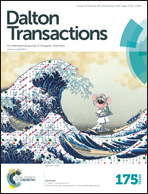Structural snapshots in the copper(ii) induced azide–nitrile cycloaddition: effects of peripheral ligand substituents on the formation of unsupported μ1,1-azido vs. μ1,4-tetrazolato bridged complexes†
Abstract
The azido ligand is widely used in coordination chemistry both as a ligand and as a metal-bound reactant. Its role as a bridge for magnetic exchange coupling has attracted a lot of attention in polynuclear metal complexes. However, only a very limited number of complexes are known in which a single azide anion, particularly in the μ1,1-mode, is the only unsupported connection between two metal centers. We present here a series of copper(II)–azido complexes with amine anchored, triazole-based tripodal ligands containing varying substituents. In the mononuclear copper–azido complexes there is only a negligible effect of these substituents on the structure of the metal complexes. However, the substituents seem to play a decisive role in the type and formation of the dinuclear complexes. Using the tripodal ligand TBTA with flexible benzyl substituents resulted in a rare example of an unsupported and solely μ1,1-azido-bridged dinuclear complex. The use of the TDTA ligand with 2,6-diisopropylphenyl moieties as rigid and sterically demanding substituents resulted in the formation of a scarce example of a solely μ1,4-tetrazolato-bridged dinuclear complex by in situ cycloaddition between the azide and solvent nitrile. This observation of a reaction of unactivated aliphatic nitrile with the azide anion at room temperature is very unusual. The isolation and characterization (by means of X-ray diffraction) of intermediates allows for mechanistic insights into the cycloaddition reaction. The isolated bridges in both dinuclear complexes render them ideal model compounds for the investigation of the magnetic exchange mediated by these ligands usually employed in polynuclear complexes and frameworks together with additional bridging ligands. Magnetic measurements and broken-symmetry DFT calculations were used to shed light on the magnetic exchange revealing weak and moderate antiferromagnetic exchange for the azide and tetrazolate, respectively.


 Please wait while we load your content...
Please wait while we load your content...